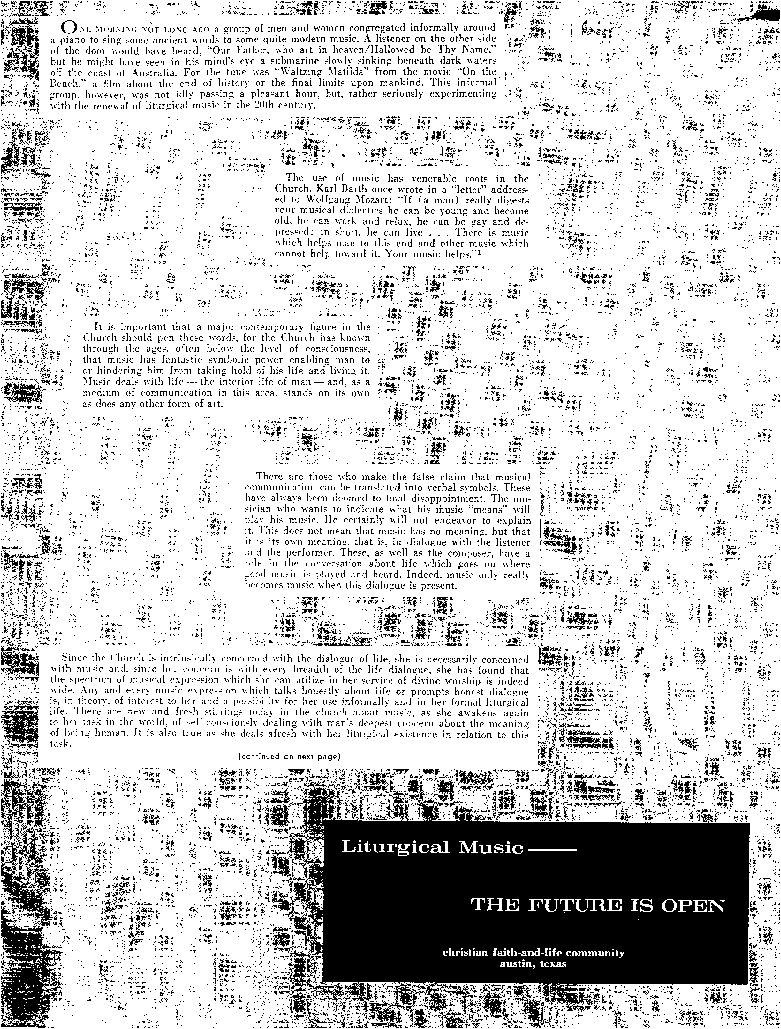
 |
The early church had some suspicion of music. It is no wonder, for she knew its power and feared its association with the mystery religions which were for her less than adequate interpreters of the human situation. This did not deter her, in faithfulness to her Hebrew lineage, however, from early using psalms and composing hymns for her services. Some of these latter made their appearance in the New Testament scriptures and are still used, for example, the Benedictus, the Glona in Excelsis Deo and the Nunc Dimittis.
Perhaps the greatest impetus to Church music in the entire history of the Western world was given to it by Pope Gregory I in the sixth century uhen he developed the musical code now known as the gregorian chant. This formulation was much more than the effort of a man to ``rite music which could be set to the ancient liturgy of the People of God. Rather, the tunes which Gregory used were already present in his day and were addressing the people who would participate in the Mass through their use. Gregory either arranged them or had them arranged to fit the words and mood of the liturgy. The gregorian chant is the result of an active dialogue with the surrounding culture and an attempt to relate the life of the Church to the tenor of the time, and to the depth of human personhood.
The music which has found its most firm place in the life of the Church and in its service has always been that which participated in the ongoing life of the common people. In our modern day, with its significant lack of historical consciousness among many people, there is little memory of the fact that much of the music which has now achieved the character of "sacred," and thus falsely isolated from the everyday stream of life, was once the common vernacular. An excellent example is the origin of the wellloved hymn and anthem from Bach's St. Mathew's Passion, "O Sacred Head Now Wounded." This melody Bach derived from a popular song entitled, "My Peace of Mind is Shattered by the Charms of a Tender Maiden."
Another common illustration of the integration of the life of the Church with the mood of its day, and the complete lack of embarrassment at this involvement, is the hymn which begins, "What child is this, who, laid to rest,/On Mary's lap is sleeping?" William Dix in the 19th century set this nativity poem to a melody which boys on the street were singing about a woman of somewhat less than acceptable reputation among the higher elements of society, nicknamed "Greensleeves" because of the color of her favorite dress.
The 18th century produced the hymns of the Wesleys as a part of the dynamic spirit of the age. John and Charles Wesley, eager to reveal the relevance of the Christian gospel to those who uere not a part of the established church, began to sing their hymns on the street corners, in coal mining camps, and in the countryside meetings which were called for preaching and singing. The Weslevs were not concerned, in the main, with the source of the tunes to which their hymns were sung, just so long as they were suitable for being sung easily by persons who uere not musically trained. Many of the tunes which were used in the Methodist meetings, consequently, were those which the miners and factory workers and their wives hummed and sang at work and about the home and neighborhood. Many of them had associations which the good churchgoing people of the day would not have approved, but for those who were just beginning to understand in the core of their being that the Word of the Gospel was meant for them, the earthy songs of their history provided the natural setting for the new life and joy in the Christian faith.
In the 18th and 19th centuries, Protestantism became overtly a singing Church, with the people singing in the congregation, giving vent to their exultation in the faith through the medium most amenable to total personal expression. Such congregational singing may be the most significant development in the musical life of the Church. This was the period in which the tremendous thrill of the discovery, of new worlds caught the imagination of men and lifted them to heights of expression. It ``as also, and not unrelatedly, the Age of the Great Awakening in the Church when, once afresh, the depth of human rebellion against life has uncovered and the Word of Life in Christ became a new reality. Here again the dialogue between the Gospel and the times ``as held together in music, both questioning and affirming the time. In and through the musical symbols, they were enabled to be present to their experience of living in the great Kingdom of Christ in the midst of this great world, issuing in the worldwide missionary movement and the powerful thrust of the Social Gospel
In the last part of the 19th century, as our 20th century began to come into focus, with its new sober view of a world in which confidence in the immense and inevitable progress of man is shattered, music in the church took a turn - maybe a tragic turn. First, the so-called revival songs came into being which, though often confused with the hymns of the Wesleys and the Great Awakening, in actuality had only the faintest resemblance to them. The revamped "gospel" hymns rejected the hidden desire of their singers to escape from the stark reality of life through a sentimental longing for the past and yearning for the future, apparently enabling them to endure the sufferings of the given life in the present time.
Second, in reaction to the sentimentality of the gospel songs, the 20th century produced the "Director of Music," an office which has often tended to become autonomous from the other functions of the church and to separate the congregation from its music life. Here, music, though often great and significant, became an end in itself, isolated from the rest of the liturgy, an embellishment to the beauty of the service or an opportunity for certain singers in the congregation to display their voices singly and in concert.
These recent developments in the music of the present church (the "gospelistic" songs and the detached official church musician) have separated the actual singing of the song from the totality of the symbolic response to the Word in Jesus Christ. Both are a reflection of a false disjunction between the rational and the nonrational aspect of man's being. The one appeals to a man's undeveloped emotional sense alone; the other, to a more sophisticated but detached appreciation of art. Both neglect the involvement of the whole man which is integral to the Word of the gospel.
Leaving aside for now other forms of art, certainly music has the peculiar role of an capacity to address the emotional dimension of the human psyche, or of providing the avenue through which man's feelings are released or gathered into the total symbolic dimension of life. "It can," as Suzanne Langer says, "articulate feelings without being wedded to them."2 Yet the problem remains, as Langer again says, that music alone is "an unconsummated symbol."3 Man is a being of both feeling and reflection. And these facets are never separated, each is dependent upon the other and only together they form a unified whole. The person who would be whole has both the reflective image and the emotional tones of life blended together into meaningful symbols by which he grasps both his actings and sufferings in this world - that is, understands himself and therefore can and must make a decision about that selfunderstanding
Music is a symbol that manifests latent buried feelings about life as it actually is It has symbolic power only when it is fused with or into the reflective life images which it, itself, helps to forge thus, creating a total, living, dynamic symbol, which mediates a man's core relationship to life Through this symbol a man is able to grasp and manifest his essential being in action, becoming ~ ho he is in the world. It is through music that man, from primitive time to now, has held together his reflective and unreflective being, creating organic symbols in which his total being is reflected and whereby it may be expressed. Herein we truly experience our experience and decisively act our action. Thus music is neither just an emotional affair nor is it reducible merely to serving the intellect.
Our is a time in which only that which is rationally comprehensible is admitted into reality. At the same time we are a people who are bursting out all over emotionally. Ways must be found authentically to blend these. This points to music but, when music is enlisted to serve either of the above abstractions, it entrenches the fragmentation of our lives: entrenches our hiding from our total being. This is what we feel is happening currently ``ith the churches relative to music. Something must be done. This takes us back several hundred words to the corporate ministry of the Christian FaithandLife Community gathered about a piano singing the Lord's Prayer to the tune of an Australian folk song. The Community is engaged in liturgical music experimentation on the grass roots level as a part of its continuing dialogue relating to the recovery of worship. The experiment began with deliberation although, as is often the case, concrete patterns emerged only after the work had begun.
Last spring the corporate ministry of the Community produced a television program, "Dialogue," in which the movie, "On the Beach," was discussed in terms of the meaning of human existence which was therein reflected (see Letter to Laymen, March, 1960). In working on this presentation, the Collegium was struck with the fact that the musical score of the movie was "Waltzing Matilda," a melody and lyric familiar to large numbers of people as a song to be sung about the evening campfire as a "fun song." The entire nation felt the force of this film and of the song and, maybe more important, the blending of the movie and the music. For the Christian FaithandLife Community, they quickly became a symbol for the Word that it is possible to pick up one's dying life and live it meaningfully even in the face of certain impending death. When the experiment in renewed liturgical music began, this song and its new, significance was in the Community's memory. Perhaps one uill not find it surprising that members of the Community began to sing liturgical words-the Lord's Prayer-to the tune of 'Waltzing Matilda" and were caught up short that, in doing so, something was happening to them. At this point the concrete ministry of the song blended with the historic ministry of the prayer to produce an organic symbol, and a new experiment was underway.
Several months passed while the seed of 'Waltzing Matilda" germinated, and the Corporate Ministry began to think out in depth what an experiment of this kind might mean for the Church. When, this past fall, the endeavor to set the liturgy to tunes which were currently in the
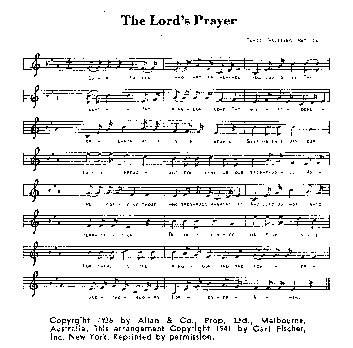 |
popular mind was entered into with great seriousness, the Community began to recall specifically the heritage of the Church in her use of music, and was astounded at the even more than expected use of popular melodies with liturgical words. This, coupled with our own experience raised the question of "why" and the serious experiment in relating traditional liturgical formulas to contemporary. popular music was the result. It would take a separate article to describe what has taken place in our understanding of and our participation in the cultic aspect of our Community as a result of this endeavor. Only some indices can be given here.
First of all, we experienced, in a new sense, the drawing together of the world as we live it and the Gospel message, and hence a drawing together of our deep unarticulated feelings about life and the self conscious images in which we as a Christian Community rise. Another significant consequence is overcoming the tendency, in spite of intellectually knowing better, to make the traditional liturgical formulae into some kind of objective philosophical statements to which we must give our rational assent. With the "culture music" undergirding they become what they are - "art forms" - great poetry uwhich talks of personal meaning, not objective truth. This has led us to see that some such thrust as we are experimenting with may be most useful in overcoming the seeming sterility in the theological recovery in our time. In no age of the church has there been as widespread and deep theological awakening as in this present day. Yet it has remained, thus far, too much a matter of the intellect and for the sophisticate, and has not caught the pew and the whole man in the pew. Maybe music is one bridge which wil1 serve.
As a result of intentional deliberation, several "ground rules" v ere soon in operation. First the tune selected should be one that had rather Obviously ministered unto the inner being of our time in some depth in whatever concrete fashion, had therefore captured the "fancy" of a rather large cross section of the American public, and was at the same time very simple and easy to sing.
Second the tunes were to be used as they were written and transmitted to the public. In other ages the Church had taken melodies and altered them to fit the lyrics which they had at hand. This had produced beautiful and effective music, but it resulted in the necessity to relearn the songs in order to sing them in the service. The music now used should be such that any person `~ho knew, for example, "Waltzing Maltida," could immediately pick up the liturgical words.
The third ground rule which emerged in the inception of the experiment, was to make certain that no words were changed in the English rendition of the liturgy. Again, the Fathers from time to time took the liberty of changing the Gloria or some other liturgical form to fit the music at hand. Without depreciating this action or even suggesting that it is not a valid one for today, the Corporate Ministry wanted to make certain, as with the tune, that these settings could be picked up without relearning and sung from memory.
Fourth, the music used was to reflect the life mood with which the particular liturgical poem was dealing, especially as it, itself, was a reflection of the tone of that part of the service in which it is used.
In the Community's Daily Office as in many services of Christian worship, the Lord's Prayer comes at the conclusion of the act of confession and absolution. This act is the act of death, in which the gathered community acknowledges itself to be in the grave, and therein hears the Word which is Life. Thus, at the end of this act, the mood is one of coming forth from the tomb with the grave clothes stil1 hanging from one's limbs. This mood matches precisely the present associations with "Waltzing Matilda " which song can hardly be sung, after "On the Beach," without visualizing the submarine coming forth from the life which is death into death (the radiation infested atmosphere) wherein is offered the possibility of Life, and then sinking into the water of death with its living persons. When the Lord's Prayer is sung with "Waltzing Matilda" the congregation dances with death as the whole meaning of life is held together in the total symbolic mode.
In the second act of the service the mood changes.
Here the grave clothes are thrown off and the radiant garments
of Life are donned. The mood is one of lilting exuberance at release
from the power of death. It is in this act that the Church has
sung hymns and anthems and from time to time, has rolled in the
aisles. It is in this act that the ancient refrain of the Church,
"Glory be to the father, and the Son, and the Holy Ghost,"
has rung forth. A tune fitting this expression of release and
excitement is needed, and the Community settled upon the ancient
march of the children, "This Old Man," the music theme
of the film, "The Inn of the Sixth Happiness." In this
movie, the Chinese children sing gaily the lilting strains of
"This old man, he played one . . ." as they march into
freedom. It is peculiarly appropriate that this melody should
be used in the second act of the service for it is as a child
that one enters into the Christian faith, as one born anew, who
begins life fresh in the light of a new av`areness of the
significance of being received in the world.
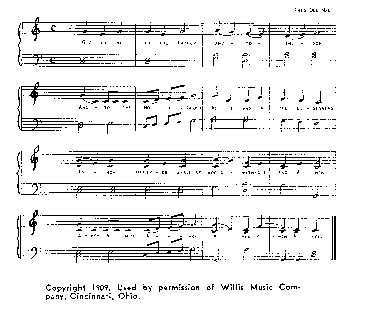 |
In the second part of act two another mood change occurs. At this point in the service, the people take their seats in order to listen to the Word as it is declared in the reading of the scriptures and in the con temporary spoken sermon. In response to the confrontation with its life therein revealed, the congregation stands to affirm together, through the Apostles Creed, the Word of Life which it has received. The mood of this recitation is one of sober jubilance, not the ecstatic glee present in the Gloria.
A careful look at the Creed reveals the fact that it is no statement of irrational belief, but rather, it is a hymn, a poetic declaration of the entirety of the Christian Faith. As such, it has three stanzas, one each for the Father, the Son and the Holy Ghost. Far from being a statement of propositional belief, these stanzas reflect the way in which life comes to the faithful man in terms of the limits of his life, the Word that he can live in these limits, and the concrete decision to embody the Word he has received.
Is there a broadly popular melody that seemingly captures such paradox? Several suggest themselves, depending upon the life experiences and reflection of the searcher. One that emerged in the spontaneity of experiment ~ as again from a motion picture, "The Bridge On the River Kwai." Those who saw the movie wil1 remember the British troops whistling the tune, "Colonel Bogey," as they marched out to do precisely the job they had decided to do even as they lived in a prisoner of war camp. To this music, the men resolutely faced the life that had been given them, and the melody attracted to itself the symbolic meaning of this response to life. We are informed by Boosey and Hawkes, Inc., of New York City, the holders of the copyright to "Colonel Bogey," that al1 texts used with this music must be approved by the
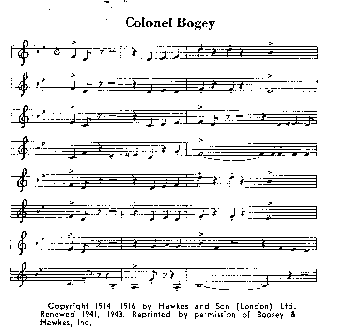 |
estate of K J Alford (the composer), and that they have been requested not to submit any further texts at this time However, they have graciously granted us permission to reproduce excerpts from this melody as an illustration of contemporary popular music which embraces troth the despair oI life and the joy of receiving and living that despair Here is a melody which catches the fresh mood of our day in its cheerful, lilting, whistled tune set in the midst of the measured march of men who have made the decision to live their absurd situation to the full
Whatever the music chosen as the medium, it will have to deal with the fact that the Creed is not a simple poem The mood is not uniform throughout Like the total worship service, its tone and attitude change from act to act or stanza to stanza Consequently, melodies used with the Apostles Creed must be such that this change in mood is integral to them Fortunately, our time has produced popular music which contains this ambivalence in mood, as is evidenced in "Colonel Bogey"
The Creed does not fall into easy cadence as do many of the other liturgical expressions Thus, it may be separated, metrically, in many ways, one example is the following
I
I believe in God/. the Father/AImight/y/ Maker/of heav en/and/earth/ And/in Je sus/ Christ/.His/ on Iy/Son our/Lord/ Who u as con/ ceived/ ~ bythe/Holy/Ghost/ Born of/. the Vir gin Ma/ry/ Suf fered/. under Pon tius/Pi late/ was cru ci/ fied/dead and/ bu ri e d/
II
He/. de scend ed/into/hell/ Th third day/ He ro/se a/gain/ Fro m/. the/dea d/. Hea/ scended/i nto/hea~ n/e an d/ sit teth/. onthelright/hand/ of God/ the Fa ther/AImight/y/ From thencc/. He sha 11/come/e to judge the/ quick/and the/dead/
III
I be lieve/. inthe~/Holy/Ghost/ The/. Holv/Cath olic/Church/ Th'com mun ion/. of/saints/. Thefor/ give/nessof/sins/. The res sur/ rec tion/ofthe/bo/dy/ And the/ life ev er/last/ing/ A men/ A/men/. a/
//men/
The mood of the third act of the service of Christian worship is the one into which the congregation marches with the creed It is a mood of joyful sober compassion which assumes responsibility for all the relationships of life In the third act the congregation decides to participate fully in all that goes on in this world In so doing the liturgy offers praise to God for the world in which, and for which, the Church is responsible, through the refrain known as the Doxology. This hymn, which begins, "Praise God from whom all blessings flow,/ Praise Him all creatures here below," is set square in the center of the act o{ offering, and catches up the mood of the action of responsibility
One of the songs which has been in the recent memory of our present culture and which has caught the spirit of this time of transition from the despair of meaninglessness to the possibility of genuine life in the midst of meaninglessness, is "Jamaica Farewell " This tune, as all calipso, made popular by Harry Belafonte, holds the precarious tension between the joy of life and the despair at the limits of existence It can be experienced as either sad or gay, depending upon the mood of the person participating in it Actually, it is holding together sadness and gaiety at the same time Suffice it to say that this melody fits precisely the mood of the Doxology as it is sung in the worship service.
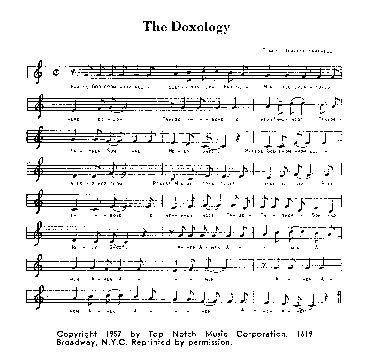 |
The experiment in liturgical music has barely begun in the Christian FaithandLife Community Other tunes and other liturgical poems are already being sung as the Corporate Ministry goes about its daily task of developing an experimental research and training center on behalf of the Church of Jesus Christ An example is the 23rd Psalm set to the tune of "High Noon " Shortly, other of the psalms wil1 find their contemporary musical setting, as ·ill perhaps the ancient hymns of the Church, the Te Deum, the Benedictus, and on and on In addition, tunes alternative to those noted here have live liturgical possibilities, and are being experimented with
The future is open As the Church begins once again to engage in relevant conversation with the world in which she is set, neu creativity will be released to fashion the living symbols by which the Church will live her life in the days to come Certainly music will be part of that new symbolic power The future is open
1. Barth, Karl, "Wolfgang Amadeus Mozart," Religion and Culture, Leibrecht, Walter (ed.). New York: Harper & Brothers, 1959, p. B3.
2. Langer, Susanne K., Philosophy in a New Key. New York: The New American Library of World Literature, 1948, p. I9B.
3. Ibid, p. ISIS.